The Skylake Core i3 (51W) CPU Review: i3-6320, i3-6300 and i3-6100 Tested
by Ian Cutress on August 8, 2016 9:00 AM ESTGrand Theft Auto V
The highly anticipated iteration of the Grand Theft Auto franchise finally hit the shelves on April 14th 2015, with both AMD and NVIDIA in tow to help optimize the title. GTA doesn’t provide graphical presets, but opens up the options to users and extends the boundaries by pushing even the hardest systems to the limit using Rockstar’s Advanced Game Engine. Whether the user is flying high in the mountains with long draw distances or dealing with assorted trash in the city, when cranked up to maximum it creates stunning visuals but hard work for both the CPU and the GPU.
For our test we have scripted a version of the in-game benchmark, relying only on the final part which combines a flight scene along with an in-city drive-by followed by a tanker explosion. We record both the average frame rate and the percentage of frames under 60 FPS (16.6ms).
For this test we used the following settings with our graphics cards:
| Grand Theft Auto Settings | |||
| Resolution | Quality | ||
| Low GPU | Integrated Graphics | 1280x720 | Lowest |
| ASUS R7 240 1GB DDR3 | |||
| Medium GPU | MSI GTX 770 Lightning 2GB | 1920x1080 | Very High |
| MSI R9 285 Gaming 2G | |||
| High GPU | ASUS GTX 980 Strix 4GB | 1920x1080 | Very High |
| MSI R9 290X Gaming 4G | |||
Integrated Graphics
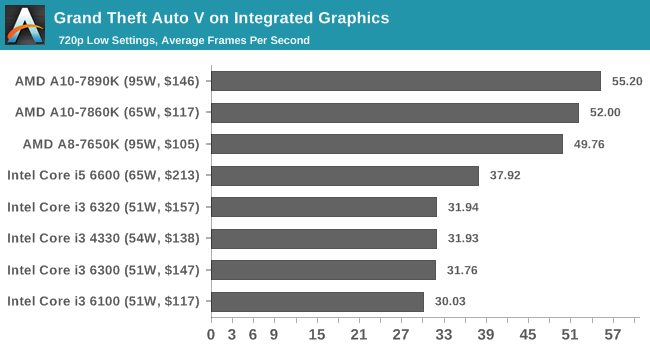
![Grand Theft Auto V on Integrated Graphics [Under 60 FPS]](https://images.anandtech.com/graphs/graph10543/83071.png)
The APUs take a large, almost double FPS lead for average frame rates, and again the Core i3 staircase shows that the L3 cache makes a difference. On the Low FPS graph, we see that none of the Intel CPUs make it above 60 FPS at any point, whereas the APUs can expect to see 15-30% of their time at or above 60 FPS.
Discrete Graphics
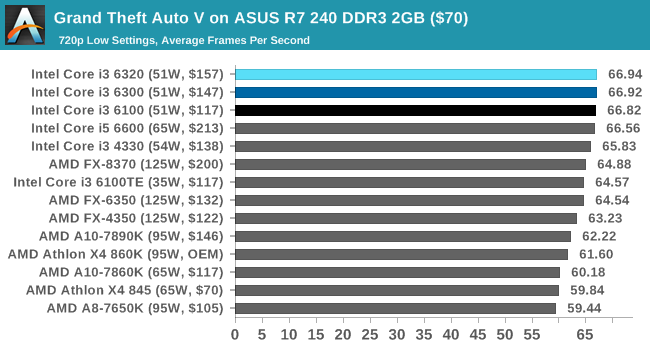
![Grand Theft Auto V on ASUS R7 240 DDR3 2GB ($70) [Under 60 FPS]](https://images.anandtech.com/graphs/graph10543/83079.png)
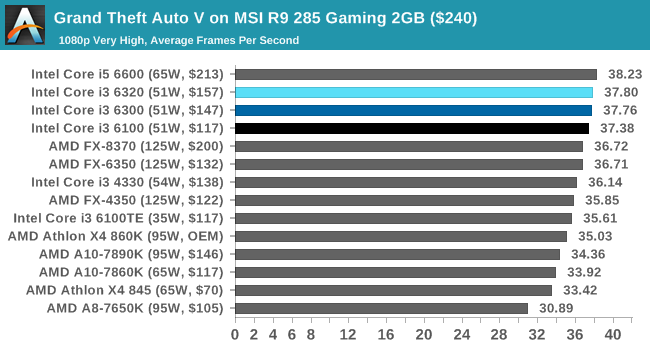
![Grand Theft Auto V on MSI R9 285 Gaming 2GB ($240) [Under 60 FPS]](https://images.anandtech.com/graphs/graph10543/83087.png)
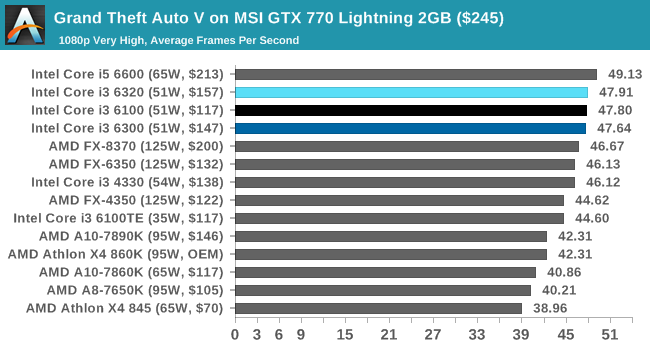
![Grand Theft Auto V on MSI GTX 770 Lightning 2GB ($245) [Under 60 FPS]](https://images.anandtech.com/graphs/graph10543/83095.png)
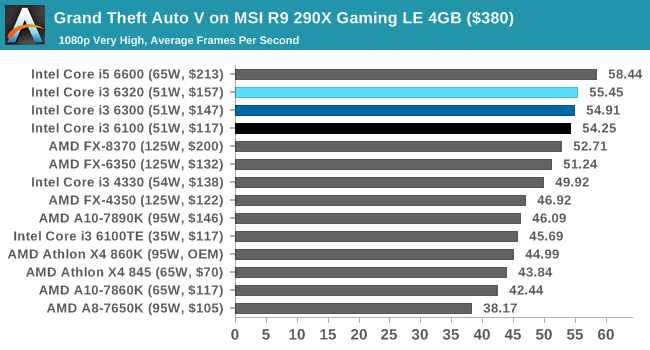
![Grand Theft Auto V on MSI R9 290X Gaming LE 4GB ($380) [Under 60 FPS]](https://images.anandtech.com/graphs/graph10543/83103.png)
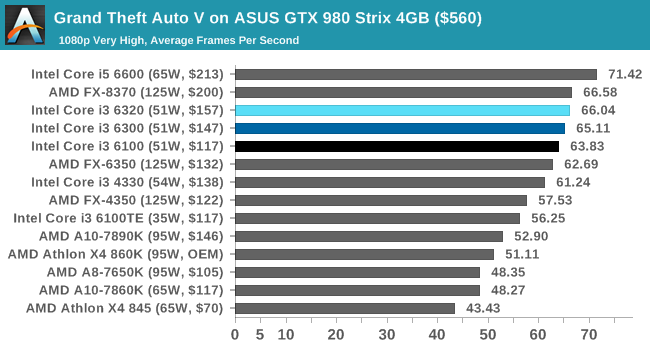
![Grand Theft Auto V on ASUS GTX 980 Strix 4GB ($560) [Under 60 FPS]](https://images.anandtech.com/graphs/graph10543/83113.png)
It's an onslaught of data, but clicking through to each graph will expand it in finer detail.
Again, with a discrete GPU, the Core i3s sit very pretty at the top of our graphs. In most cases, against similarly priced AMD CPUs, they can be from 5% to 20% quicker in average frame rates - the higher power the GPU, the more that it matters.
An interesting graph is the final one, with the GTX 980 and lookng at the percentage of frames over 16.6ms (i.e., the percentage time the game spends under 60 FPS). With the Core i3 parts, the game spends at least 50% of its time above 60 FPS running at 1080p Very High settings, however with similarly priced AMD APUs, this drops down to 15-25%. While running at V-Sync, this will be noticable. The FX CPUs get a better showing with the GTX 980, with the FX-6350 and the FX-8350 straddling the Core i3s for average frame rates and the 60 FPS metric.











94 Comments
View All Comments
tipoo - Monday, August 8, 2016 - link
Looks like even a Skylake i3 may be able to retire the venerable 2400/2500K, higher frame rates and better frame times at that. However a native quad does prevent larger dips.Kevin G - Monday, August 8, 2016 - link
I have a feeling much that is due to the higher base clock on the SkyLake i3 vs. the i5 2500K. Skylake's IPC improvements also help boost performance here too.The real challenge is if the i3 6320 can best the i5 2500k as the same 3.9 Ghz base clock speed. Sandy Bridge was a good overclocker so hitting those figures shouldn't be difficult at all.
tipoo - Monday, August 8, 2016 - link
That's true, overclocked the difference would diminish. But you also get modernities like high clocked DDR4 in the switchover.At any rate, funny that a dual core i3 can now fluidly run just about everything, it's two cores are probably faster than the 8 in the current consoles.
Lolimaster - Monday, August 8, 2016 - link
Benchrmarks don't tell you about the hiccups when playing with a dual core. Specially with things like Crysis 3 or even worse ROt Tomb Raider where you get like half the fps just by using a dual core bs a cheapo Athlon 860K.gamerk2 - Monday, August 8, 2016 - link
That's why Frame Times are also measured, which catches those hitches.Samus - Tuesday, August 9, 2016 - link
I had a lot of issues with my Sandy Bridge i3-2125 in Battlefield 3 circa 2011 with lag and poor minimum frame rates.After long discussions on the forums, it was determined disabling hyper threading actually improved frame rate consistency. So at least in the Sandy Bridge IPC, and probably dating back to Nehalem or even Prescott, Jackson Technology or whatever you want to call it, has a habit of stalling the pipeline if there are too many cache misses to complete the instruction. Obviously more cache resolves this, so the issue isn't as prominent on the i7's, and it would certainly explain why the 4MB i3's are more consistent performers than the 3MB variety.
Of course the only way to prove if hyper threading is causing performance inconsistency is to disable it. It'd be a damn unique investigation for Anandtech to do a IPC improvement impact on it's affect on hyper-threading performance over the years, perhaps even dating back to the P4.
AndrewJacksonZA - Wednesday, August 10, 2016 - link
HOW ON EARTH DID I MISS THIS?!?!Thank you for introducing me to Intel's tech known as "Jackson!" This is now *SO* on my "To Buy" list!
Thank you Samus! :-D
bug77 - Monday, August 8, 2016 - link
Neah, I went i5-2500k -> i5-6600k and there's no noticeable difference. The best part of the upgrade was those new I/O ports on the new motherboard, but it's a sad day when you upgrade after 4 years and the most you have to show is you new M2 or USB 3.1 ports (and USB 3.1 is only added through a 3rd party chip).Sure, if I bench it, the new i5 is faster, but since the old i5 wasn't exactly slow, I can't say that I see a significant improvement.
Now, if you mean that instead of getting an i5-2500k one can now look at a Skylake i3, I'm not going to argue with you there. Though (money permitting) the boost speed might be nice to have anyway.
Cellar Door - Monday, August 8, 2016 - link
This is a poorly educated comment:a) Your perceived speed might be limited by your storage
b) You don't utilize your cpu's multitasking abilities fully(all cores)
Duckeenie - Monday, August 8, 2016 - link
Why did you continue to post your comment if you believed you were making poorly educated points?